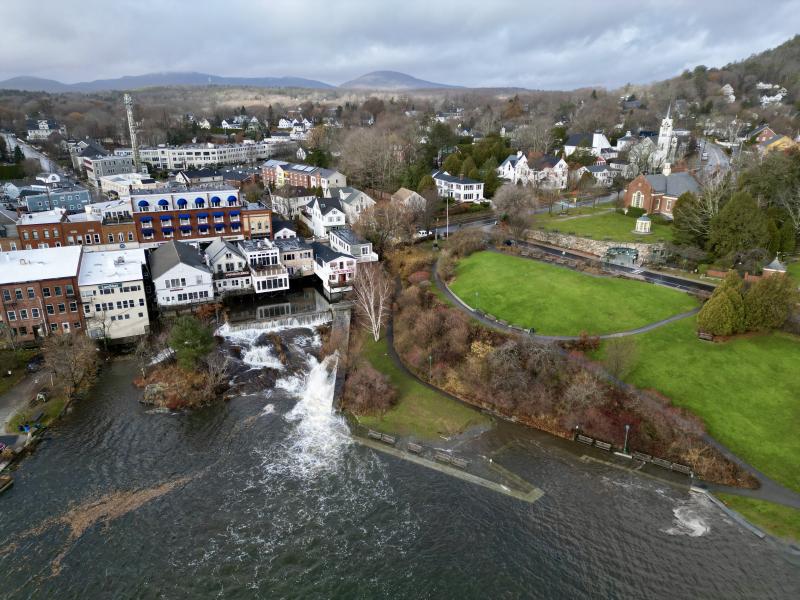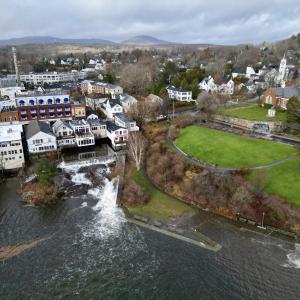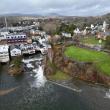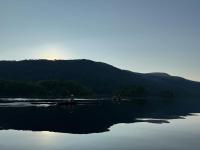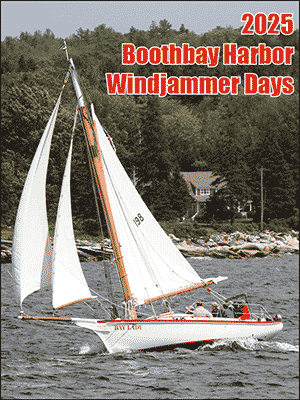If you still haven't decided about the dam
I can't be the only one who sometimes has to do a little last minute cramming before a vote. As Camden residents prepare to vote on the removal of the Montgomery Dam, it's clear that many people made up their minds a long time ago, but I know some of you are just trying to figure out the basics. There's a lot of back and forth everywhere and most of it gets into the weeds, so I will try to answer the most prominent questions I'm receiving here quickly.
- This proposal is essentially asking if Camden residents agree to remove the dam and restore the free flowing river as long the whole thing is paid for without taxpayers and the funding also covers everything needed for the Harbor Park sea wall and pathways.
- There is no "do nothing option" because the entire area needs major reconstruction and will likely require fish and/or elver passage on the dam within the next decade. A no vote signals that you want to spend additional time and resources rebuilding the dam and sea wall without federal assistance. We will also need money to support more committee work and designs.
- The proposal has the support of the Megunticook River Citizens Advisory Committee, the Natural Resources Council of Maine, Camden Public Library, Camden Conservation Commission, Coastal Mountains Land Trust (largest landowner in the watershed), Trout Unlimited, the Passamoquoddy Tribe, and many more. It's identified as a priority watershed for sea-run fish restoration by the Maine Department of Marine Resources, NOAA, and the National Fish and Wildlife Foundation.
- If the dam stays, it will eventually require fish passage. Dams without fish passage are a little like the failing septic on the family camp. We are getting away with it now, but we know it won't be allowed forever. Everyone thought that there'd be some magic compromise option to make everyone happy by keeping the dam and building fish passage. So far, no one has liked those compromises and they've all been expensive. Tony Grassi even spent his own money hiring a historic preservation specialist to design a compromise that was presented.
- The Montgomery Dam has nothing to do with the lake level and you won't even notice at Shirttail. In fact, even now, the pond behind the dam is often drained for maintenance of structures and the change goes unnoticed by everyone on the river further away than the Villager Cafe.
- This is happening all over the country and Maine. Dam removals are being fully funded because the benefits to wildlife are good the broader ecosystem, especially commercial fisheries. The China Lake outlet stream had three fish passage projects put in and three dams removed. The Town of Farmington removed a dam and the grant funding paid for the whole thing plus a new park next to the river.
- All dams have a finite life and they get very expensive and often dangerous near the end of it. We are in a period where removal of some dams is being incentivized in much the same way that the Clean Water Act insentivized wastewater treatment plants. We can do the right thing now and take advantage of incentives or we can wait until we are forced to make changes.
- What will it look like? Basic concepts have been done based on detailed engineering. The landscape components can still change based on refinements by the library board of trustees if the vote passes. Below is one basic concept design showing park space moved to higher bedrock areas and the river cascade returning to area now subject to flooding. More can be found here: https://www.megunticookrivercac.com/pages/9e808eb41dc24b6990f30ef6faf17fa4

(Image courtesy Town of Camden)
Where is the money coming from?
The short answer is not from property taxes! It would be hard for people to make a decision if they have to speculate on the volatile federal funding environment. For this reason, the question is worded very strongly to make the authorization contingent on the funds. If grant funding falls apart, we are in the same place as we are today, needing to find ways to pay for picking things up in Harbor Park and repairing leaks in the dam with our own money.
To date, most of the funding for studies, design, and public engagement has come from the National Coastal Resilience Fund (NCRF). None of this current funding has been impacted by federal actions and the same is true for most projects funded by similar programs locally and elsewhere. However, no funding source can be considered a sure thing until it is awarded, and the approval asked for from voters recognizes that.
The NCRF is a partnership between the National Fish and Wildlife Foundation and the National Oceanic and Atmospheric Administration (NOAA) with additional private funding from Shell, TransRe and others. The funding for this program has historically been supported by administrations on both sides of the aisle, but a large increase in funding for these programs came from the inflation reduction act in the bipartisan infrastructure act. After 2026 the funding already appropriated by Congress will be at or near its end and any future allocations may change dramatically.
The National Coastal Resilience Fund, along with other similar programs, offers grants specifically for "nature-based solutions" that help communities like ours reduce vulnerability to coastal storms and flooding from extreme rain events when it can be done in a way that supports habitat recovery of regional and national significance. Every town faces rising costs and water related issues from storms and aging infrastructure and they are competing for small buckets of money with endless competition. What is special about this project is that we can address our inundation problem at Harbor Park and our leaking, crumbling dam in a way that provides immediate benefits to important species.

(Photo courtesy Alison McKellar)
Why is your "Yes" vote essential for securing this funding?
A critical requirement for obtaining these substantial grant funds, particularly for construction, is the approval of the property owner – in this case, the Town of Camden. All grants are awarded on a competitive basis and depend on other similar projects. Grant makers want to know that when they allocate funds for a project, that it’s a project that will actually happen. A "yes" vote from Camden residents and the expressed support of the Camden Public Library Board of Trustees is the best way to provide this surety. Without this approval, securing the necessary construction grants becomes impossible. No funder is going to set aside millions of dollars to fund projects that may not happen.
What about history?
The project will include historical signage, preservation of a portion of the dam as an overlook to stand on, reuse of most of the granite originally selected by the Olmsted Brothers and Mary Louise Curtis Bok, and the entire process will be carried out in accordance with and exceeding the standards of the National Parks Service guidance for potential historic resources. The full history of the site will be better documented than ever before, with an emphasis on the human and geological history over time.
I created a video about six years ago about the history of the river and some of the questions about its future. We have learned even more since then but all the information is still correct and it provides an aerial flyover with some interesting history.
Do we know enough?
During one of our Select Board meetings, the town attorney said it might be the most studied issue by any committee in the history of the Town. The Megunticook River Citizens Advisory Committee (MRCAC) has been studying the issue for 2.5 years, reviewing what was already done starting in 2017. The goal was to have a new group of people with open minds and fresh eyes review the recommendations from previous feasibility studies.
That committee of 9 voted 8-1 to remove the dam and redesign the connected Harbor Park sea wall with final design details determined by the Camden Public Library Board of Trustees (as per the deed restriction).
Megunticook River Citizens Advisory Committee summary report, maps, and statements from each individual committee member.
Town of Camden Megunticook page with links to reports, visuals, meeting links, presentations from students, assessments demonstrating that dam removal improves conditions for structures in the river, and cost estimates.
Camden Public Library Board of Trustees statement and supporting documentation for their recommendation to vote yes on article 7. Essentially, the Camden Public Library fundraises about half of their budget and control over Harbor Park. There are some big expenses coming up, and the sea wall, which is connected to the dam and occupies a portion of the original river channel, is severely compromised and has already fallen over. Funding for dam removal is attractive because it will also cover all of plans for the harbor park sea wall, saving the town roughly 3 million dollars in capital costs and much more over the course its lifetime.
Why are we just voting on just one dam? Don't we need to know what the plan is for the whole river?
There is a detailed feasibility study and design work for all the dams. The recommendation over time is to remove the dams in the downtown and strengthen and upgrade the ones upstream which have recreational value (East, West, and Seabright). This is very common in watersheds throughout the country. A combination of dam removal and fish passage installation. In fact, multiple dams have already been removed in Camden on the Megunticook River.
Will it totally dry up?
It is already possible to see the worst case scenario with dam removal. There are sections of the river that are not impacted by dams and you can see the free flowing state. These places don't have the steep drop off that the harbor falls will have, but it's the same quantity of water flowing over bedrock and boulders along the tannery riverwalk, at the Rawson Avenue bridge, under the bridge near Megunticook Market, and all along the riverwalk from the Seabright Dam to the Mount Battie Street Pump Station. There is a minimum flow requirement from the lake dams and we already know what it looks like in those places at minimum flow. I think everyone would agree that it is still attractive and you can still hear the sound of the river. The Montgomery Dam pond, at minimum flow, does get complaints for the visual impact. The concrete on the dam becomes visible and the pond heats up and leads to algae growth, often dropping below the level of the spillway.
Does it do any good for the fish if they can't get to the lake?
In addition to the long term benefits of eventual passage throughout the watershed for alewives, there are also immediate benefits to brook trout, rainbow smelt, juvenile american eels, and water quality by removing this one dam. Anadromous rainbow smelt were once prolific in Camden Harbor and rely on spawning habitat in fast moving coastal streams near the head of tide. Restoration of the river channel through the intertidal zone currently being inundated during high tide events would provide immediate access to critical habitat while also dramatically reducing mortality of juvenile american eels. Both species are commercially important. Brook trout benefit from being able to move around a watershed as conditions change. They go back and forth between salt and fresh water, deep lakes, and shallow, cold streams depending on the season and temperature. Today, its a one way trip for Maine's heritage fish once they end up on the harbor side of the Montgomery Dam.

Brook trout and alewives beneath the dam in spring 2024. (Photo courtesy Alison McKellar)
Can't we just do nothing?
Yes, but the dam will look awful and Harbor Park will get more dangerous. If this were out in the middle of nowhere, we could conduct a long term experiment where we simply don't pick the sea wall back up when it collapses and we slowly allow the dam to leak more and more or for the gate to become stuck and building owners to be unable to drain the pond. It would look very bad and also cause safety concerns. When the dam is leaking through the main portion, water trickles down through Harbor Park and washes out the land from above, compounding the issues with regular overtopping of the wall from ocean related events. The photos below show what happens with the do nothing option. This even happens with doing anything other than total reconstuction.
 .
.
(Photo courtesy Alison McKellar)

(Photo courtesy Alison McKellar)

(Photo courtesy Alison McKellar)

(Photo courtesy Alison McKellar)
Finally, if you want to see a bunch of videos of fish and flooding combined with an original song that Alice Limoges wrote urging a focus on nature based solutons as we look to the next 100 years, take a moment to watch here:
Alison McKellar lives in Camden and is a member of the Select Board.

